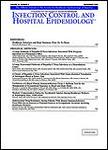版权所有:内蒙古大学图书馆 技术提供:维普资讯• 智图
内蒙古自治区呼和浩特市赛罕区大学西街235号 邮编: 010021

作者机构:Hackensack Medical Center Hackensack and New Jersey Medical School Newark New Jersey Alta Bates Medical Center Berkeley California University of Washington Medical Center Seattle Washington Hartford Hospital Hartford andthe University of Connecticut School of Medicine Farmington Connecticut Hospital Infections Program Centers for Disease Control and Prevention Atlanta Georgia Magee Women's Hospital and University of Pittsburgh School of Medicine Pittsburgh Pennsylvania University of Iowa Hospitals and Clinics Iowa City Iowa
出 版 物:《Infection Control & Hospital Epidemiology》
年 卷 期:2015年第15卷第3期
页 面:189-192页
学科分类:12[管理学] 1204[管理学-公共管理] 120402[管理学-社会医学与卫生事业管理(可授管理学、医学学位)] 1004[医学-公共卫生与预防医学(可授医学、理学学位)] 10[医学]
摘 要:Objective:The objective of this quality standard is to optimize the treatment of bacteremia in hospitalized patients by ensuring that the antibiotic given is appropriate in terms of the blood culture susceptibility of the pathogen. Although this standard may appear to be minimal in scope, it is needed because appropriate antimicrobial treatment is not given in 5% to 17% of cases. To implement the standard, physicians, pharmacists, and microbiologists will need to devise a coordinated ***:We considered criteria for appropriate dosing, most cost-effective selection, proper antibiotic levels in serum, least toxicity, narrowest spectrum, specific clinical indications, and optimal duration of treatment. All these criteria were rejected as the basis for the standard because they were too controversial and too difficult to be applied by a nonphysician chart reviewer. In contrast, the selection of an antibiotic to which the pathogen is sensitive is a non-controversial criterion and easy for a chart reviewer to ***:The standard is designed to reduce the incidence of adverse outcomes of septicemia such as renal failure, prolonged hos-pitalization, and ***:Several well-designed clinical trials without randomization as well as case-controlled studies have confirmed the benefit of using an antibiotic that is appropriate in light of the susceptibility of the isolate in blood culture. Prospective, randomized, placebo-controlled trials are not ***:Our premise is that the presence of bacteremia is a risk factor for serious adverse outcomes. We also believe that the administration of antibiotics must always be guided by the susceptibility report for the pathogen(s) obtained from blood cultures. This concern is more critical for pathogens from the blood than for those from most other body sites. We had evidence that susceptibility reports for pathogens from positive blood cultures were not always used properly. We used group discussion t